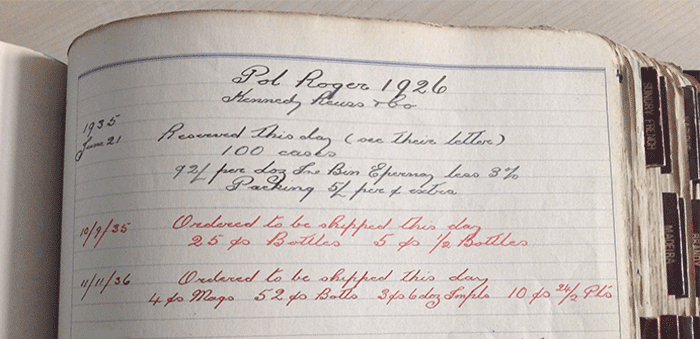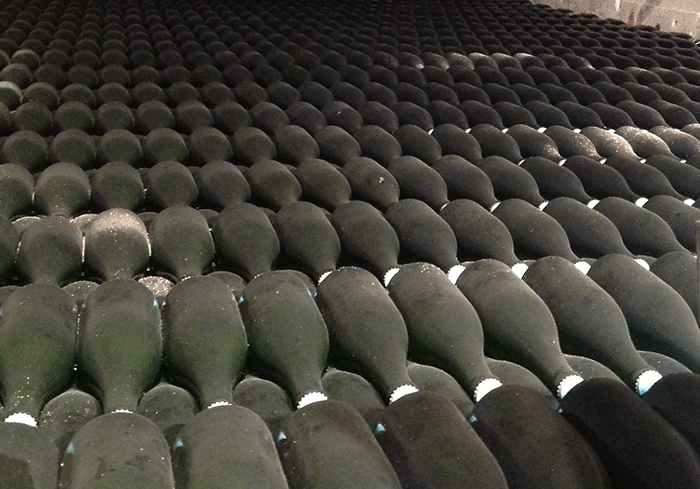“I couldn’t live without Champagne – in success you deserve it and in defeat, you need it”
Author: Berry Bros. & Rudd

Our order ledgers from the 1920s show Berry Bros. & Rudd’s customers have always had a penchant for Pol Roger
a superlative vertical tasting – at Pol Roger, the home of Winston Churchill’s
favourite Champagne
Journeying towards Epernay, the heartland of Champagne, through Vallée de la Marne – with its vineyards changing from green to warm-autumn rust-red – is beautiful. Enjoying a few bottles of non-vintage Pol Roger on the train only enhanced the view. The Fine Wine team’s tasting trip to the esteemed Champagne house had begun well.
We arrived in time for dinner with Hubert de Billy, the fourth generation of the Pol Roger family. A number of family members are still involved in the company, and its history is fascinating. The domaine was founded in 1849 by Pol Roger, the son of famous solicitor, who had inherited some vineyards (and a passion for winemaking) from his mother’s side. Our meal got off to an auspicious start with Croustillant de Homard (filo-wrapped lobster) matched with 1988 Pol Roger Blanc de Blancs which, remarkably, was still very youthful. Capturing the finesse and sophistication of great champagne, Pol Roger Blanc de Blancs remains under the radar in the UK.
We then moved on a decade to enjoy the 1998 Pol Roger en magnum with tender lamb and petits legumes. Over this course, Hubert told us how, in the 1950s, his father converted the family’s hunting lands to vineyards (much to the chagrin of some of the family who enjoyed shooting wild boar and ducks). It was a decision that proved critical to the survival of Pol Roger.
The next morning, we visited the winery, and had the honour of being the inaugural guests to see the new vat room. At a cost of €15million, it has been a huge – albeit essential – investment for the family. The new 200 tank capacity means it is now possible to separately ferment the 80-90 different parcels and grape varieties. In the search for purity of fruit, Pol Roger introduced a second débourbage (clarification process); it’s also the reason for the exclusion of oak (the last oak vats were used in 1975) and cool fermentation at 16-18C. There are no presses in sight – Pol Roger presses all the grapes in the vineyards to retain fruit character and prevent oxidation of the must. Just after the harvest, the newly fermenting Pinot Noir must is deeply coloured and pinkish – I find it difficult to believe that the colour will totally disappear.
After the tour of the new winery, we visit the maze of subterranean cellars. Eight million bottles are stored in the 7.5km of underground tunnels, representing about five years of production and the layers of bottles quietly resting are an impressive sight. Equally impressive is seeing the manual riddlers at work. (Riddling is the art of turning the bottles slowly to consolidate the lees – dead yeast – into the neck of the bottle prior to removal). It’s a dying art in Champagne that is being kept alive by quality-conscious houses such as Pol Roger: the house employs four full-time riddlers.
The bottling line is our final stop. At Pol Roger, all the magnums and large-format bottles are disgorged (when the lees are removed) by hand – these guys must pop record-numbers of Champagne bottles! The pressure in a Champagne bottle is huge at 5 atmospheres (almost three times the pressure in your car tyre) and so the glass bottles are extra strong. Pol reckons that in the early 1900s it lost five percent of its production to exploding bottles. Finally, all magnums and larger are hand labeled.
A final treat was in store for us: a vertical tasting of Pol Roger Winston Churchill. I rarely taste the top cuvée of the house and I don’t think I have ever heard of anyone holding a vertical tasting, so this was a very special treat. First produced in 1975, the blend for Winston Churchill remains a house secret, but it is Pinot Noir dominated. The vintage Pol Roger spends between three-and-a-half and four years on its lees, but Winston Churchill spends 10 on its lees, producing an outstanding Champagne. My thoughts were as follows:
2000 Pol Roger, cuvée Winston Churchill
A rich, creamy and almondy nose is followed on the palate with surprising richness. A taut purity balances the richness, which transcends the quality of the vintage. Layers of exotic fruit blend with rich lemon mousse. Lower acidity makes this very approachable. It is a bold style of Winston that is starting to take on weight already. Sadly a small crop in 2000.
1999 Pol Roger, cuvée Winston Churchill (Disgorged July 2012)
The 150th birthday of the house. A creamy nose, with more pronounced bubbles than the 2000. Richer, more Burgundian in style. A beautiful finish of baked almonds, baked pineapple covered in baked almonds. The soft acidity is somehow comforting like a fur stole on a crisp winter’s day.
1998 Pol Roger, cuvée Winston Churchill (Bottling spring 1999, disgorged in 2008)
Smoked almonds, beautifully structured with an energetic lift. On the palate are layers of red currants, amazing freshness, finesse and elegance. The most powerful, well-structured of the wines tasted so far, but finely finished with a finish that goes on for 30+ seconds. I would drink this after I have finished my 1999s.
1996 Pol Roger, cuvée Winston Churchill (disgorged February 2007)
We tasted two bottles as the first one had a slightly muted profile. The second bottle, however, was truly impressive. Enormously concentrated and dense, with a textured crunchy finish and a white floral linear line throughout. Throughout the tasting I kept coming back to this and it is captures all the strength of the vintage. An exceptional Winston that requires further cellaring.
1995 Pol Roger, cuvée Winston Churchill (disgorged in 2005)
A hard act to follow after the 1998 and 1996 and it does not share the same density or flavour profile. An attractive champagne with pretty lemon zest.
1993 Pol Roger, cuvée Winston Churchill (disgorged in 2003)
A white Burgundy nose with roasted chestnuts. The acidity is noticeable, on the palate there are ripe backed lemons and an aromatic smoky finish.
1990 Pol Roger, cuvée Winston Churchill (disgorged Oct 1999)
Despite a big crop, this is a real success. An opulent, flamboyant Winston, with well integrated acidity, a pronounced mousse and delicious white spice. The team was divided in preferring the direct and openness of the 1990 or the more complex 1988. Drinking very well now.
1988 Pol Roger, cuvée Winston Churchill (disgorged February 2004)
For me this has the edge over the 1990. It is beautifully structured, with fine bubbles that are well integrated as is the vibrant acidity. The palate is filled with graceful layers of white flowers. It tastes much more youthful than the 1990 and will be longer lived. Arguably one of the greatest Winston Churchills.
1986 Pol Roger, cuvée Winston Churchill (disgorged in 1996)
Interesting to try, but personally this was too old for me (we had two bottles and the second bottle was slightly fresher). Pronounced mushroom notes, green nettles and cheesy rind.
Having returned to the office, I came across our old ledger and it was a good reminder of how long we have enjoyed Pol Roger. The styles may have changed slightly over the past few decades, but the quality has always remained fabulous. I am looking forward to the 2002 Winston Churchill, which we expected to be released in Spring 2014 and though we didn’t taste it, I have heard good things – so this story will be continued…



